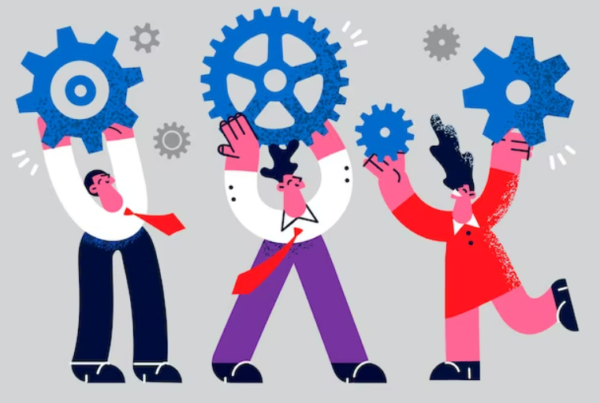When workers are sufficiently engaged, businesses can increase their profits by 21%. In fact, firms are now putting a lot of attention on the employee experience.
Prior to realizing that it’s even more important to be “employee centric,” businesses were competing to be the most customer-focused. After all, your staff are the ones who come into contact with your clients and prospects at many touchpoints. Both you and your employees disregard your clients. Employee commitment and loyalty increase as they feel more valued, respected, and cared for by their employer.
So how precisely can you enhance the employee experience? According to Josh Bersin, the core components of the employee experience are five: meaningful work, hands-on management, a productive atmosphere, opportunities for growth, leadership trust, and health and wellbeing. It begins when you onboard a new employee, which is the ideal opportunity to establish a connection and set the tone for their experience.
In the blog post below, we have further broken these components down for you. Let’s start!
1. Create a fantastic onboarding process
A new hire’s first professional encounter takes place during onboarding. They need to be given a tour of the organization’s vision, culture, and rules. It is necessary to modify the curriculum for various departments and job grades.
For example, the onboarding process for a new hire in customer service and a new hire in marketing should differ. After that, people must be informed and provided with the resources they can use. To aid the new hires with their tasks and adjust to their jobs, a buddy or mentor might also be assigned.
2. Hold one-on-one meetings
The management of the employee experience is now a continuous process and should not be left only in the hands of HR. Every employee’s relationship with their team manager and the business is extremely important. One-on-one meetings are one of the finest strategies to develop and strengthen the relationship.
Team meetings are ideal for discussing the work schedule, progress, and praising good work, but one-on-one meetings should take place at least once a month, or more frequently if an employee’s performance suddenly starts to decline.
Since not everything, positive or negative, can be expressed in front of everyone, it gives room for dialogue and encourages the employee to open up. This activity promotes leadership trust, which is crucial for a positive workplace environment.
3. Increase internal dialogue
The function of internal communication is frequently limited to sharing company news, accomplishments, and similar information. Most people are unaware of the role internal communication may have in enhancing and preserving the employee experience. You may develop a humble community of workers who promote you in their networks and work devotedly to produce work that impacts only by making internal communications more interactive and interesting.
Try creating a calendar using the same tool you use for social media platforms. The distinction? Here, you consider how to include your workforce. Posting simple inspirational sayings, comments from the creator, encouraging staff to show off their skills, and sharing puns as long as they are not disrespectful all work. Increase the level of engagement by selecting a topic for the month and experimenting with various formats, such as movies, graphics, gifs, etc.
4. Appropriate payment
Our fundamental motivation for working is to earn a good living and create the lifestyle we desire. Good pay has therefore always been an unspoken element of a positive employee experience. It’s simple to guarantee that your employees are happy with their compensation at all times. Start by hiring the employee at or near the raise he anticipated, monitor performance going forward, and reward excellent work with commendable bonuses, frequent coupons, and appraisals that occur at least twice a year.
5. Possibilities for growth and learning
According to surveys, a startling 87% of millennials consider opportunities for professional or career progression to be crucial. Only 39% of them, however, firmly concur that learning anything new in the previous month improved their performance at work.
If that weren’t shocking enough, you should also be aware that high-performing workers prefer to continue working for companies where the work is difficult and meaningful. Once the activity is finished, doing such work gives individuals a rush of adrenaline and a sense of accomplishment.
You must promote knowledge-sharing sessions led by employees for other employees if you want to succeed in this field of employee experience. Make timely promotions and fair evaluations, and ask teams or employees for course recommendations.
6. Wellness initiatives for workers
Employee wellness programs have taken on a whole new meaning in the wake of the pandemic. They go far beyond a standard health insurance plan that assists employees in times of illness. Employee productivity increased during the pandemic because corporation profits was put below employee welfare.
It must go on and be regarded as the way work will be done in the future. Companies must continue to be committed to looking out for the emotional, spiritual, physical, and mental well of their employees as the topic about mental health has become more mainstream this time.
Focus on keeping them healthy in all four areas by using easy methods like implementing a flexible work schedule, updating and increasing the leave options, constructing an office gym, hosting online Zumba classes, and more. It is also becoming more and more popular to include an online health insurance software that allows employees to contact a doctor or talk to a therapist for free online.
7. Team-building exercises
The best icebreakers and relationship builders are team building exercises; they inspire and unite your personnel. They facilitate communication between team members and those in other departments, encourage creativity, and increase productivity.
8. Bring staff members to conferences
You can also make the announcement at the beginning of the goal-setting process that the top performers will be invited to international conferences and events, both offline and online, in order to maintain employee enthusiasm. The announcement would give workers a sense of value and motivate them to engage in healthy competition with one another.
9. React to criticism
Employers have begun to hear their workers’ opinions about them and everything else that counts, but that is only the beginning. The next step is to really act on the feedback after consistently listening and accepting it.
If this isn’t done, confidence is lost, and moving forward, employees might not even bother providing input, whether it’s been requested or not. Start distributing the survey results and the improvised action plan. Begin designating and holding accountable those who work with you for implementing the changes.
10. Trust in a leader
It is only right that you demonstrate your appreciation for the time and effort your employees have invested in helping you reach your long-term business objectives. Make sure that every communication from those in leadership incorporates and reflects the company’s objective and purpose. Transparency, inspiration, and honesty should all characterize the communication.
The smallest actions, such as including workers in the discussion and considering their opinions and suggestions before making a significant decision that affects them or the business, can make the biggest difference in this situation.
11. Provide flexible scheduling
Employees now expect more than simply a fair salary; they have attained a new level of self-realization and actualization. The candidate-driven market is becoming more prevalent. A flexible shift planning approach will aid in enhancing the working environment for staff members. Employees can work when they are most effective based on their preferences.
When it comes to “job flexibility,” shifting shifts and having flexible hours of operation are highly sought for. Additionally, it would be frequently used in the future to request shortened workweeks, part-time employment, job sharing, annualized hours, and teleworking.
12. Grant paid leave
Every company offers paid time off to its workers, but in certain businesses it is still frowned upon. The paid time off you provide your employees will also define their experience with you and their willingness to work with you in the post-pandemic era, taking into account the current changes in the workplace.
Define mental health leaves, period leaves, vacation leaves, paternity leaves, and other types of leaves in your paid time off policy.
13. Manager training
Managers play a crucial role in enhancing the employee experience since they serve as the main point of contact between employees and the business. Employee experience is improved in direct proportion to the manager’s personal and professional relationships with his staff.
It would be beneficial to train managers on how to combine being their employees’ office friend and the manager while also being a good listener and motivator. Additionally, they can learn about goal-setting, delegating, time management, and feedback-sharing techniques.
Conclusion
You must map out the normal employee journey, pinpoint the “moments of worth,” get their input, and then take appropriate action. This would undoubtedly assist you in closing the gap between where you are now and where you want to be in terms of the employee experience.
You must be aware that this path to improving your employee experience won’t be taken just once once you embark on it. Because of how unpredictable and constantly changing human behavior and the workplace are, nothing can really be set in stone. Additionally, each employee would be at a different stage in their journey and have a different set of experiences.
The request is to listen intently, often, and to respond promptly. After all, a good employee experience would have a favorable impact on all important outcomes, including engagement, productivity, and satisfaction.




